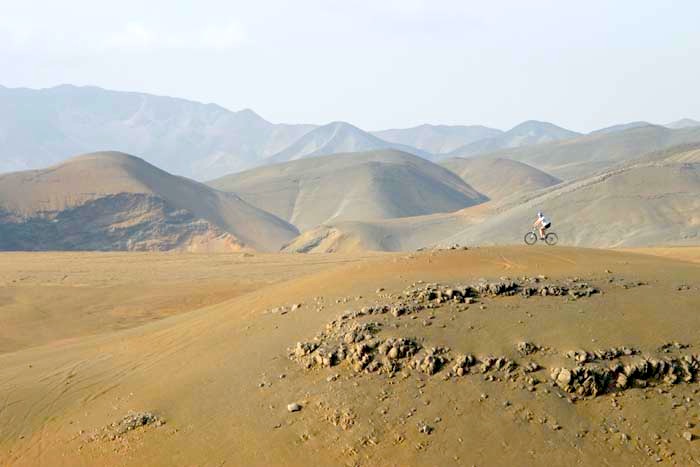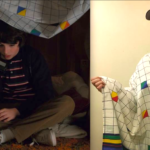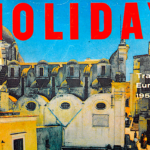My companions and I have been driving south down the stunning desert coast of Peru for nearly a day before we begin to wonder what the locals call this parched stretch of land that skirts the Pacific. We’ve all heard of the Atacama Desert in Chile, and the dry basins of Patagonia in Argentina, but none of us knew Peru was home to impressively huge sand dunes and sprawling, rocky wastelands. Curious, I inquire at a gas station south of Chiclayo.
“What is the name of this desert?” I ask the attendant as he wipes down my windshield.
“This,” he says, happily gesturing at the barren expanse all around us, “is not a desert.”
I look skeptically out at the dry landscape. “What do you mean? Does it rain here often?”
The attendant grins. “It almost never rains here. It is like a desert.”
“But you just said this isn’t a desert.”
“That’s right,” he says. “This is not a desert.”
Perplexed, I pose the same question to a handful of Peruvians in the gas station snack shop, and they all tell me the same thing: This dry and dusty coastal strip of Peru – even with its jagged moonscape and curving sand dunes – is not a desert. It is something else. Something that, for whatever reason, does not have a name.
Few visitors to Peru know of this coastal desert, and fewer still make any effort to see it. Rather, travelers visit Peru for its legendary Andean peaks, lush Amazonian jungles, ancient Incan ruins and lake-studded highlands – and it is certainly no different for my eight traveling companions and me. For the past two months, we’ve been driving four Land RoverDiscovery II vehicles through Central and South America as part of the “Drive Around the World” expedition, a global drive-athon that aims to raise money for Parkinson’s research. Our stated expedition goal is to circumnavigate the globe on lines of longitude in just nine months – and we were hoping to travel the 1,000 or so miles from the Ecuadorian border to the Andean heights of Cusco as quickly as possible. Hoping to avoid the inland mountains entirely, we’ve been taking the Pan-American Highway in a straight shot south along the coast. As expected, the road is excellent, and we’re making good time.
Completely contrary to expectations, however, this road passes through sudden stretches of the most gorgeous desert I’ve seen since I traveled the Mongolian Gobi and the Egyptian Sahara. Oddly, unlike the Gobi or the Sahara, this desert had no reputation and (as far as I can tell) no name.
Admittedly, my map of Peru does name one desert on the extreme northern coast: a smallish, mostly uninhabited region known as the Sechura Desert. When we drove across the Sechura yesterday afternoon, however, we found it relatively wet and vegetated. Indeed, thanks to idiosyncrasies in the El Nino climatic phenomenon (which originates off this stretch of coast every few years and affects weather patterns around the globe), the Sechura Desert has recently been host to the second-largest body of water in Peru – a freshwater lake 90 miles long, 20 miles wide and 10 feet deep – which was formed when freak rains in 1998 caused rivers bordering the desert to burst their banks and flow into the lowlands. To this day, large portions of the Sechura Desert are studded with stubborn shrubs and scrub grass.
By contrast, long stretches of the Peruvian coast south of the Sechura Desert – a narrow, nameless strip that separates the Andes and the Pacific for more than 1,500 miles before merging with Chile’s Atacama Desert – have been utterly barren. Rocky brown hills line the horizon, and huge, pale dunes bump the edges of the Pan-American Highway; swirling patterns of sand hover over the blacktop as we drive our Land Rovers south.
As we make progress into Peru, however, the coastal geography begins to make sudden changes. Just as I’m getting used to the sweeping desert surroundings, I will crest a ridge and drop down into a blindingly green river valley, studded with villages and sown with lush, irrigated fields of sugarcane, cotton and alfalfa. Then, just over another ridge, I’ll drop back down into a lifeless desert.
It takes a flurry of map research before I’m able to figure out what I’m seeing: Though this Peruvian coast receives little annual moisture beyond a dirty winter fog, more than 40 rivers roar out of the Andean highlands with enough force to cross the desert and reach the sea. Each of these river valleys creates its own riparian oasis, and – thanks to the rich highland silt contained in the waters – agriculture thrives here, supporting towns and cities all along the Peruvian coast. Unlike most rainless areas of the world, the Peruvian desert is home to a large population, including four of the nation’s five largest cities.
As a result, my experience of the coastal desert tends toward the schizophrenic: An hour’s drive through an eerily empty landscape will abruptly end with a clutch of mud-brick homes, a gaggle of children chasing goats and a cement water tower advertising 7-Up. What looks from a distance like a sudden meadow of colorful flowers turns out to be a roadside garbage dump fluttering with red and yellow trash bags. In this way, the inherent romance of desert isolation continually gives way to dirty, vibrant riverside communities. Majestic wasteland alternates with commuters cramming into rusting Dodge Charger taxis, campesinos piling sugarcane into ancient lorries, and old women selling Chiclets and lollipops from roadside kiosks. My biggest danger as a desert wanderer hasn’t been the risk of thirst, but the sudden appearance of handcarts, livestock, and – on more than one occasion – stray dogs languorously pooping in middle of the Pan-American Highway.
At the end of my first full day amid this quirky succession of desert and oases, my expedition teammates and I stop for dinner at the town of San Pedro de Lloc, reputedly known for its culinary delicacy of stuffed lizard. Though we can’t seem to find a lizard dinner, we do manage to locate a pleasant roadside eatery full of local retirees eating chicken and swilling beer. Since gangs of half-drunk old men tend to be instant experts on all manner of worldly topics, I quiz them on the name and nature of this coastal landscape. A ruddy-faced man named Jose is happy to accommodate.
“The people you talked to before were very stupid,” he declares grandly. “This place is definitely a desert.”
“Does it have a name?” I ask.
Jose clutches his beer and confers briefly with his compadres. “This desert does not have a name.”
“Why doesn’t it have a name?”
A shrug. “I think because it is not a very good desert.”
“And why isn’t it a good desert?”
The old Peruvian waves his free hand in a vague gesture of frustration. “This place is like a desert, but it is not a desert.”
“But what’s the difference? Why is it like a desert, but not a desert at the same time?”
“Because,” Jose declares confidently, “it does not have a name.”
None the wiser about our desert surroundings, my companions and I drive another hour and stay the night in a guesthouse near Puerto Chicama – an area revered with equal fervor by surfers and archaeologists. For surfers, this stretch of coast is home to the longest left-breaking wave in the world – and some surf stalwarts claim it as the true birthplace of their sport, since 1, 500-year-old pottery from nearby Huanchaco depicts ancient Peruvians perched atop waves on tatora-reed rafts. Archaeologists are more interested in the fact that the Chicama River valley lies near the heart of theMoche Empire – a pre-Columbian civilization that rivaled the Incas, the Mayans and the Aztecs as one of the most sophisticated cultures in the New World.
Like the nameless desert that surrounds it, the remnants of Moche culture have gone strangely unheralded in the popular imagination. Australian hippies may travel halfway around the world to summon the spirits at Teotihuacan, Toronto housewives may make life decisions based on the ancient Mayan calendar, and busloads of German tourists may flock to the ruins of Machu Picchu – but Moche wonders such as Sipan and the Temple of the Sun are largely unvisited. Interpretive information is lacking at most of the Moche archaeological sites, grave robbers have made more important discoveries over the years than scientists, and one of the best collections of artifacts from the era is housed in the basement of a Mobil gas station in Trujillo.
The main reason the Moche Empire is so neglected as a great New World civilization is simple: While the Incas, Mayans and Aztecs built their monuments in stone, the oasis-dwelling Moche built in mud and adobe. Since the decline of the Moche culture more than 1,000 years ago, it has only taken a few random El Nino rainstorms each century to wipe away most of their pyramids and monuments.
Nonetheless, archaeologists have been able to determine that the Moche built roads and extensive irrigation canals to feed the first real urban culture in South America. Important culinary staples included fish, guinea pigs, squash and peanuts (which were sometimes depicted in gold and silver Moche jewelry). A highly ceremonial priest class ran the society, Moche doctors knew how to set broken bones, and a specialized warrior-class ritually drank the blood of prisoners. Thesewarriors sometimes sparred with one another for sport, and (in a detail that predates comic-book hero Bruce Wayne by more than a millennia) the most accomplished of these Moche gladiators were awarded bat masks. Ceramics were a highly developed art, and a number of stylized clay figurines – some of them depicting Moche couples copulating in all manner of Kama Sutra-like positions – have been unearthed by archaeologists.
Though perhaps the most colorful of Peruvian coastal cultures, the Moche did not exist in a vacuum. Settled tribes were thought to have been farming Peru’s riparian oases as far back as 4000 B.C., and the 40 or so rivers that cut through the coastal desert hosted a progression of ancient settlements that made Peru the Egypt of the New World. Near Trujillo, ruins have been found dating back to 1600 B.C., some of them containing gory bas-reliefs of heads and arms being severed in combat. Along the southern coast of Peru, the Paracas culture (thought to have originated around 1300 B.C.) mummified their dead and created some of the finest pre-Columbian textiles in the Americas. Near Chiclayo in the north, the mysterious Sican civilization left behind no less than 26 giant adobe pyramids.
Of these desert civilizations, the most well known is the Nazca culture (a contemporary of the Moche), which etched huge line drawings into the rocky soil of a plateau along Peru’s southern coast. Depicting geometrical, human and animal forms, these sprawling geoglyphs (some of them nearly 630 feet long) can only be recognized from the air – fueling speculation that these works were the Nazca’s way of communicating with extraterrestrial beings.
Since the modern-day town of Nazca is where my expedition team must leave the Pan-American Highway and head inland toward the Andes, we make a special stop to view the desert lines. While my friends take to the air to view the geoglyphs from the windows of an aging Cessna, I remain earthbound in an effort to make one last attempt at solving the nagging mystery of this anonymous desert.
Were I a better student of geography, I might have sought my answers in the science department of some regional university. Instead, I get my desert epiphany from a matronly desk clerk at Nazca’s Alegria Hotel. “The coast of Peru is a dry place,” she tells me with a shrug. “But it’s too normal here to be a desert. I think it must be something else.”
The more I consider the woman’s dismissive logic, the more it makes sense. Deserts are supposed to be foreboding places, suitable only for mystics, nomads and wavering apparitions. For Marco Polo, the emptiness of the Gobi was filled by goblins; Pliny’s Sahara was haunted by phantoms. The coastal desert of Peru, on the other hand, is populated by oases full of workaday Peruvians – and it more or less has been this way for the past 6,000 years.
Perhaps, then, deserts are as much a matter of psychology as science. Regardless of the evaporation-condensation ratio along the Peruvian coast, the desert here has remained nameless because there’s too much human company to be had. What’s a desert, after all, if it isn’t deserted?
After my friends finish their aerial tour of Nazca, we load into the Land Rovers and drive inland, leaving Peru’s crowded, dimly defined desert for the unambiguous slopes of the Andes.





